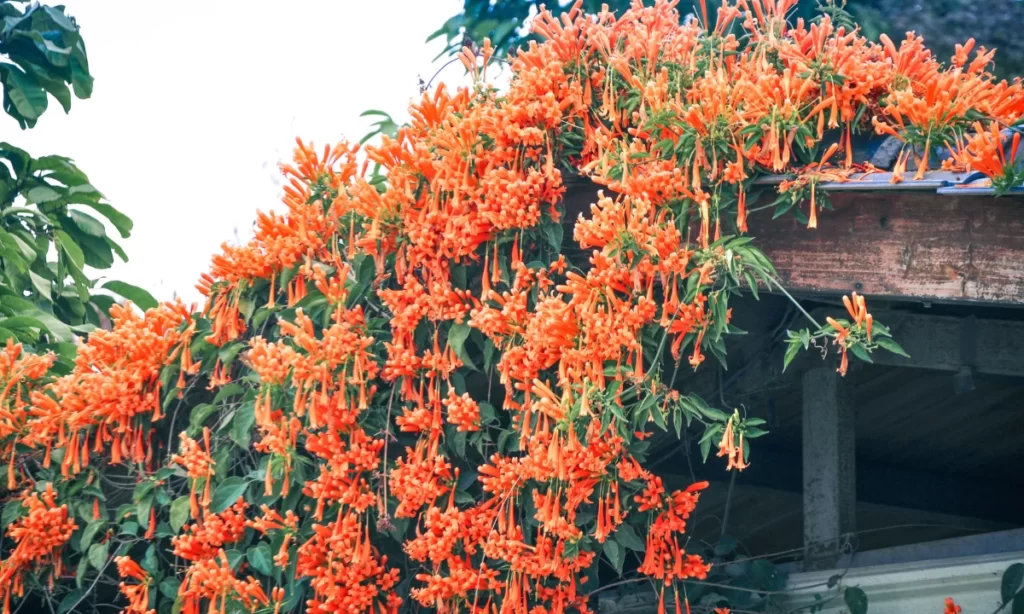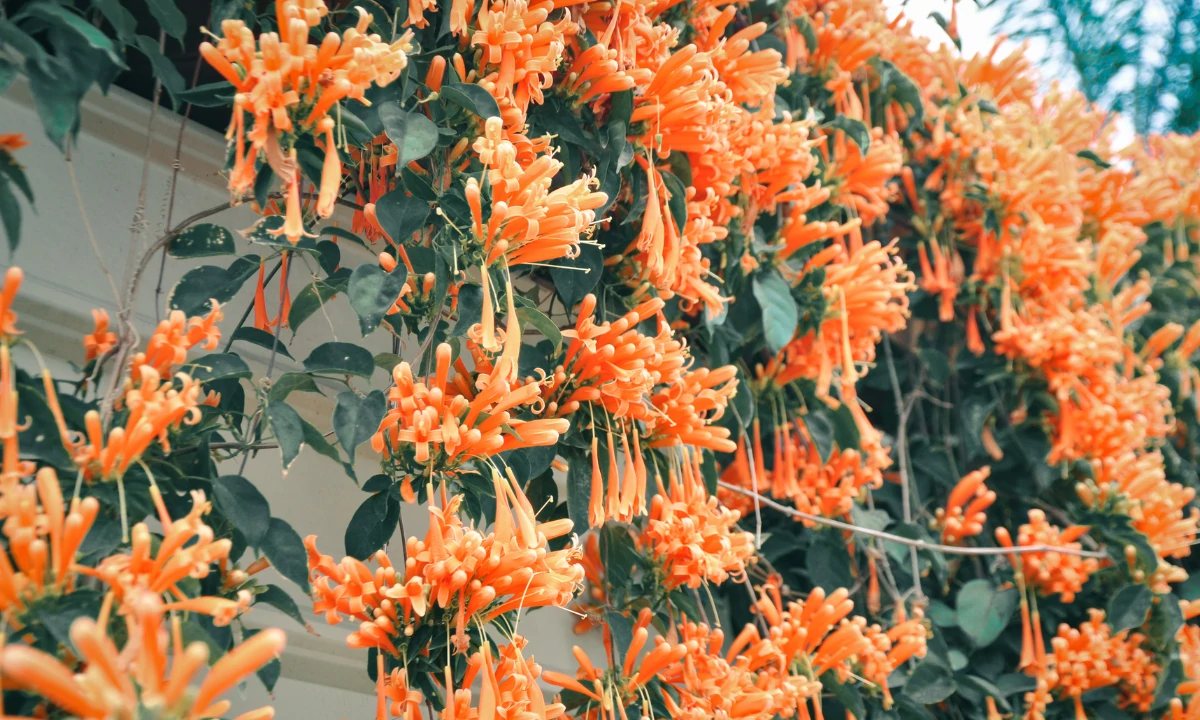Bignonia venusta, also known as flame vine or orange bignonia, is a stunning ornamental plant admired for its vibrant clusters of tubular orange-red blooms. This fast-growing woody vine is native to Brazil and belongs to the Bignoniaceae family along with other popular vines like crossvine (Bignonia capreolata) and trumpet creeper (Campsis radicans).
| Name | Bignonia Venusta |
| Common Names | Flame vine, Orange trumpet vine, Firecracker Vine, Golden Showers |
| Origin | Brazil, Bolivia, northeastern Argentina and Paraguay |
| Type | Creeper |
| Outdoor/Indoor | Outdoor |
| Soil | Well-drained soil |
| Temperature | 15-26°C |
| Water | Moderate |
| Sunlight | Full sun |
| Flowers | Long, bright orange flowers |
| Blooming Season | Winter to Spring |
| Height | 5 m at most |
With its ability to quickly cover fences, pergolas, and trellises with abundant floral color, Bignonia venusta makes an excellent addition to gardens in warm climates. While it can reach up to 40 feet in height, keeping it pruned and trained to support helps manage its size and growth habit.
Botanical Name: Pyrostegia venusta
Common names of Bignonia Venusta in
Hindi: Amaltas, अमलतास
Below is a comprehensive guide to successfully growing this eye-catching plant in your landscape.
Getting Started

When bringing Bignonia venusta into your garden, you have a couple of options for sourcing plants. Search local nurseries for potted vines typically in one to five gallon sizes. Focus on finding young, healthy plants with an established root system.
Alternatively, you can start your own plants from seeds either sown directly outside or started indoors. Soak the seeds for at least 24 hours before planting to improve germination rates.
Once you have your plants, select an ideal planting site. Bignonia venusta thrives best in full sun locations. Provide at least six hours of direct sun daily for the heaviest flowering. Select a spot with well-draining soil and ample vertical space for the vines to climb upwards.
Prepare the planting area thoroughly – amend the native soil with lots of added organic matter like compost or aged manure to improve drainage and nutrient content. Incorporate the amendments into the top 12-18 inches of soil. Install supporting trellises or other structures at the time of planting if they aren’t already in place.
Planting and Care of Bignonia Venusta

If installing nursery plants, carefully remove them from containers without disturbing the root ball. Tease out any circling roots before placing each plant in its hole. Backfill with the prepared soil, tamp down gently, and water thoroughly after planting. Space plants 8-12 feet apart depending on the intended support structure.
Seeds
Sow directly outside after the last frost date once the soil has warmed. Plant 1/4 inch deep in rows spaced 12-18 inches apart. Thin seedlings to 1-2 feet between plants after the first true leaves emerge. Harden off and transplant indoor-started seedlings similarly to nursery plants.
Water
New plantings frequently until the roots are established, keeping the soil moist but not saturated. Once established, water deeply only when the top few inches become dry. Avoid wetting foliage to discourage diseases. Drip irrigation or soaker hoses work well for vine watering needs.
Fertilize
Fertilize in early spring with a balanced 10-10-10 fertilizer or something formulated for flowering vines. Avoid high nitrogen products that stimulate excess foliage over blooms. Only fertilize established plants and always follow label directions.
Pruning and Training

Once your Bignonia venusta gets growing, it will require pruning and training to maintain shape, size, and maximize flower production. Time the first pruning back to 24 inches or so after planting when the vines are still dormant. This encourages bushy, branched growth from the base.
Going forward, prune annually in late winter before spring growth starts. Remove random shoots, crossing branches, and excessive growth to shape the plant. Cut back long stems behind flowered stalks to several buds to promote regrowth and flowering.
Train vines during the growing season onto supports as they elongate using flexible plant ties. Space out lateral shoots for even coverage. Weave stems horizontally along fences or vertically up trellises and arbors. Remove stems once they outgrow their space, pruning back as needed to control size.
Problems and Solutions

Bignonia venusta is relatively pest and disease resistant when provided proper growing conditions. But it can still occasionally encounter issues:
- Aphids, scale, and mealybugs may colonize stems and leaves, sucking plant juices. Wash off with water or treat with horticultural oils or insecticidal soaps.
- Leaf spots and rust are common fungal diseases in humid weather. Improve air circulation and avoid wetting foliage to treat. Remove severely infected leaves.
- Plants stressed by insufficient sunlight, overwatering, compacted soils, etc can become vulnerable to problems. Ensure optimal growing conditions.
- Harsh weather like storms may damage vines. Provide sturdy supports and check ties regularly. Wrap or move potted plants indoors if facing temperature extremes. Mulch root zones for insulation.
Tips for Maximizing Growth

Here are some additional tips to really get your Bignonia venusta vines thriving:
- Take 6-8 inch stem cuttings in summer for easy propagation of new plants. Dip in rooting hormone and pot up for root development.
- Boost sunlight exposure to maximize the prolific flowering these vines are known for. At least 8 hours daily is ideal if possible.
- Give vines ample vertical support like walls, columns, or pergolas to showcase their vigorous growth habit upwards and across.
- Pinch off spent blooms diligently to encourage continued flowering all season long into fall. Fertilize after major flowering peaks.
- Group plantings together for a really dramatic, bold impact. Their flowers will attract hummingbirds and other pollinators to your landscape.
Conclusion

With its fast, vigorous growth and spectacular floral displays, Bignonia venusta makes a stunning addition to outdoor spaces in warm climates. Provide this plant with bright sunlight, ample support for its climbing habit, minimal watering once established, and regular pruning to maximize flowering and control size.
Train vines each growing season to direct and contain growth. Mostly pest and disease-free, this plant will reward your efforts with months of vivid orange-red blooms sure to draw attention. Follow this guide for the knowledge to successfully grow Bignonia venusta in your own garden.
FAQs
What are the optimal growing conditions for Bignonia venusta?

Bignonia venusta thrives in warm climates with long summers. Provide at least 6-8 hours of full sun daily and well-drained soil. Avoid soggy conditions.
How much water does it need?

Water regularly after planting until the roots establish. Then only water established plants when the top few inches of soil become dry. Avoid overwatering.
When should I start pruning and training the vines?

Do the first hard prune back to 24 inches after planting while the plant is still dormant. Then prune annually before spring growth emerges. Train vines during the growing season.
What kind of supports should I provide?

Bignonia venusta needs sturdy supports like fences, trellises, columns, or pergolas for its vines to climb vertically or horizontally across.
How can I encourage more flowering?

Maximize sunlight exposure, pinch off spent blooms, and fertilize after major flowering. Also, prune annually to encourage new growth that will flower.
What pests or diseases may affect Bignonia venusta?

Aphids, scale, mealybugs, leaf spots, and rusts are most common. Fix any cultural issues increasing stress. Wash off pests or use horticultural oils/soaps. Remove diseased leaves.
Can I propagate new plants from cuttings?

Yes! Take 6-8 inch tip cuttings from juvenile growth in summer. Dip in rooting hormone and pot up. Keep cuttings moist until rooted.
